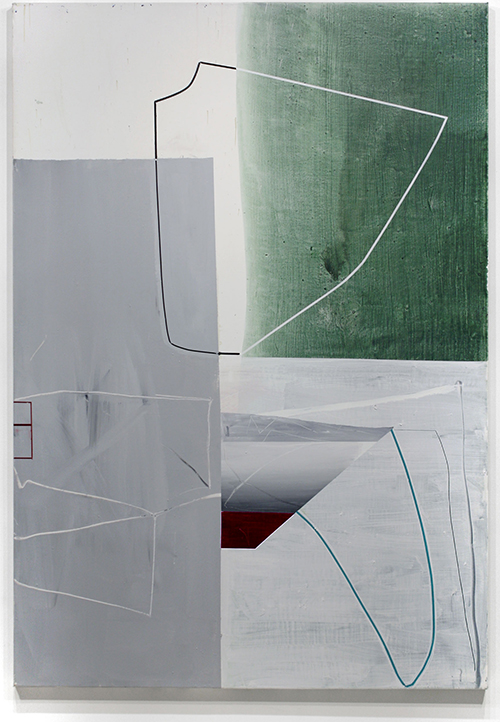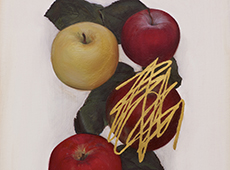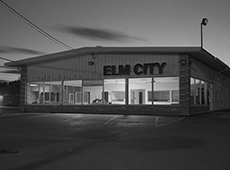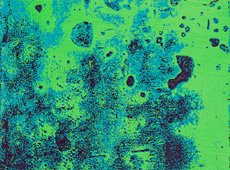No one would have, even to this day, conceived of the question: “Is drawing dead?” That would never ever occur to someone. So the question then became: What is it that happens when we go from drawing to painting that so many people seem anxious to kill? And the best that I could come up with…

Gordon Moore, “Flange, 2013. Oil, pumice and latex on canvas. 78 x 54 1/2 inches. © Gordon Moore. Courtesy of Betty Cuningham Gallery.
II
My use of line in painting also refers back to the urge to fuse drawing and painting into one act. It all goes back to drawing. I remember very clearly many years ago, when everyone was proclaiming the death of painting, that Artforum actually did a cover issue positing the question: “Is painting dead?” That issue canvassed a number of artists for their reaction to that question and I remember in reading it that one of the first things that occurred to me was: No one would have, even to this day, conceived of the question: “Is drawing dead?” That would never ever occur to someone. So the question then became: What is it that happens when we go from drawing to painting that so many people seem anxious to kill? And the best that I could come up with was that drawing was so intuitive, spontaneous and direct that it made painting in the eyes of many seem pretentiously after-the-fact and contrived. Now it was very clear at the time that the limitations imposed on painting by the strictures of academic thinking, which so many of us had dealt with coming out of the post WWII University Art School Institutions, had created a context in which one had to aestheticize virtually every act within a work in order for it to achieve competence. And part of that, part of the urge to “purify” the work, was the elimination of anything that could be interpreted as gratuitous. The origins of what came to be called “minimalism,” in my view, are just that prosaic. But there is at the same time a wonderful pictorial economy in that, which is very appealing and which had a huge impact on me. Confronting “minimalism” was pretty much the first 10 years of my life as a painter in Manhattan and I can remember many times sitting in my studio on Prince St. in the late 70’s feeling an uneasy self-consciousness at having to build on an “inheritance” that left little room for you to move in as a painter. As Robert Hughes had said at the time: “There is more to painting than a black painting by Reinhardt and a white painting by Ryman,” and I had found much to agree and identify with in that observation. So eventually, if you are going to continue painting, you have to find a way of pushing through that. What I turned to was my interest in layering structures one over the other as a way of achieving an internal depth in the picture which allowed me much more freedom of movement and much less self-consciousness, which was very liberating. I noticed that in the black and white photographs I was just then beginning to pull up in the dark room that the slightest linear element in the picture often cast a shadow which very often was entirely detached from the element which had cast it and that if I drew on top of it that I almost automatically had a certain level of depth which I could then build on or eliminate depending purely on whether or not it “worked” within the structural configuration of the piece. That was always the determining aspect: whether or not it simply worked. So the “background” marks were there already. All I had to do was respond to them. The paintings which started coming out of this mode of drawing at first had a kind-of equivalent which I had found in ink. The ink bled and I started using the bleeding as a kind-of “photographic” ground which had unlimited potential. I have just begun to scrape the surface of what I can do with that use of material. That’s essentially how the foreground/background depth (somewhat in reverse) evolved.
spacer
Up next:
“…and all the while I’m doing this I keep noticing that there is something very painterly about the way developer flows over photo-emulsion paper…”
Our conversation with Gordon Moore continues.
Editor’s Rec:
Alan Feltus: Words from Letters.
spacer
.
.
.
.
Subscribe to Tilted Arc
If you like this story, please consider subscribing. We are sticklers for privacy.
We will never sell or share your e-mail address.



